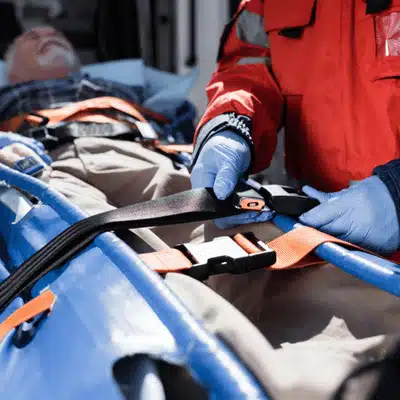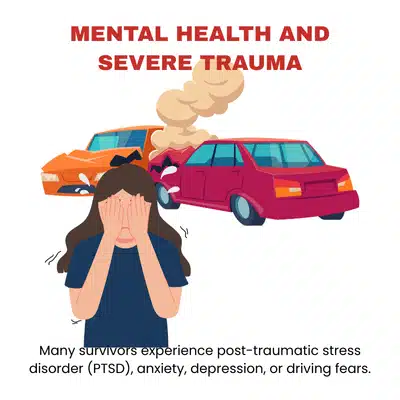Car crashes happen fast and leave victims with many types of harm. Texas alone saw over 250,000 people hurt in car wrecks during 2024. These injuries range from minor cuts and abrasions to life-changing harm that affects your health, money, and daily life.
Knowing the most common car accident injuries helps you spot symptoms early and get proper medical care. Here are the injuries that happen most often in crashes.
Whiplash ranks as one of the most common car accident injuries. It happens when your neck snaps back and forth quickly during impact. This motion strains muscles, tendons, and ligaments beyond their normal limits.
Rear-end crashes cause most whiplash cases. You might feel neck pain, stiffness, headaches, or memory issues. These symptoms can take days to appear after the crash. Other neck problems include cervical sprains and nerve damage. Most whiplash heals with proper treatment, but some cases lead to ongoing pain.
Head injuries rank among the most serious crash outcomes. Common problems include concussion and traumatic brain injury (TBI). A concussion happens when your brain hits your skull. Watch for dizziness, confusion, blurred vision, or nausea.
More severe brain trauma can cause memory loss, thinking problems, or long periods of being unconscious. Head trauma also causes facial injuries. Hitting the wheel or airbag can break facial bones or cause eye injuries. Jaw fractures happen often in crashes. Concussions need immediate medical attention and may require CT scans to check for brain injury.

Crash forces put enormous pressure on your spine and back. Victims often suffer herniated discs, broken vertebrae, or spinal cord injuries. A herniated disc happens when collision force causes the cushioning between vertebrae to bulge or tear.
Spinal cord injuries can cause paralysis below the injury site. High-impact crashes might break the spine, leading to paralysis in the legs or all four limbs. Even less severe back injuries cause chronic pain and limit movement. Treatment ranges from rest and therapy to surgery or lifelong care.
Bone breaks happen very often in high-impact crashes. The sudden force can fracture bones anywhere in your body. Ribs, arms, legs, wrists, and ankles break frequently.
Bracing against the steering wheel can cause a wrist fracture. The crash impact easily causes rib fractures in your chest. Broken ribs pose special danger because bone pieces can puncture lungs or other organs. Serious crashes can break your thigh bone or pelvis.
Some fractures are simple closed breaks. Others are compound fractures where bone pierces skin. Joints can also pop out of place. Your shoulder might dislocate or your hip can move out of its socket from crash forces. Broken bones cause intense pain right after the accident. A femur fracture may need long rehabilitation.
Not all crash injuries involve broken bones. Many affect your body’s soft tissues like muscles, tendons, and ligaments. Soft tissue injuries include sprains, strains, and contusions.
Sprains happen when ligaments stretch or tear. Strains affect muscles or tendons. Bruising damages muscle tissue. A violent impact might cause shoulder injuries or knee problems as your body gets thrown around.
These injuries might not show up right away. Swelling and pain can develop hours or days later. Common signs include swelling, tenderness, stiffness, and bruising. Severe tears like ACL damage or rotator cuff tears might need surgery. Shoulder impingement happens when tendons get squeezed from trauma. Meniscus tears in the knee often result from twisting forces.

Crash forces commonly cause cuts, scrapes, and bruising from broken glass or twisted metal. Shattered windshields can create deep lacerations. Impact with car parts causes abrasions or contusions on skin. Many cuts are shallow, but deeper cuts may need stitches or surgery.
Car accidents can also cause burns. Burns in crashes happen from fires or explosions, and chemical burns from airbag injuries. High-speed crashes may catch fire and cause severe skin burns. Even without fire, airbag deployment can cause mild burns on face and arms. Burn injuries often mean long hospital stays and specialized care.
Crashes often put unnatural force on joints. Shoulders and knees face the most risk. Driver’s hands on the wheel can slam forward, causing shoulder problems ranging from bruising to shoulder dislocation.
Knee injuries happen often when knees hit the dashboard. This can break the kneecap or tear knee ligaments and cartilage. Direct blows can tear the meniscus or create ligament damage from twisting forces. Hip injuries are another major concern in side-impact crashes. Studies show knee and hip injuries account for nearly 10% of car accident harm.
Some of the most dangerous crash injuries happen inside your body. Collision force can damage or crush internal organs, harm blood vessels, or break internal structures. Internal organ injuries may affect your liver, spleen, kidneys, lungs, or heart.
High-speed crashes can cause a ruptured spleen or torn liver. Internal bleeding poses major danger with any organ injury. You might bleed inside without obvious signs. Chest injuries are also common. Impact can cause broken ribs or bruised lungs. Rib fractures can puncture lungs and cause serious internal bleeding.
Internal injuries can be life-threatening if not found and treated quickly. Symptoms like severe belly pain, swelling, vomiting, dizziness, or passing out could mean internal damage.

Not all crash injuries are physical. Many survivors experience post-traumatic stress disorder (PTSD), anxiety, depression, or driving fears. Research shows up to one-third of crash survivors develop PTSD symptoms.
PTSD from crashes can cause flashbacks, nightmares, and severe anxiety about driving. These symptoms can significantly affect daily life. Someone may be unable to drive to work due to crippling fear.
In high-impact crashes, people can suffer crush injuries where body parts get crushed or pinned by heavy forces. Crush injuries can involve broken bones, muscle damage, and poor blood flow. In extreme cases, traumatic amputation can happen during catastrophic crashes. Losing a limb is life-changing and requires multiple surgeries, prosthetic limbs, and extensive therapy.

Medical treatment comes first after any crash injury. But you should also know your legal rights. Texas is an at-fault state, meaning the driver who caused the crash pays for damages.
If you’re hurt because of someone else’s carelessness, you can seek payment from their insurance or through a lawsuit. Payment can cover medical bills, therapy costs, lost wages, and pain and suffering.
Texas follows a modified comparative negligence rule. You can recover damages as long as you were not more than 50% at fault. It’s smart to talk with a personal injury lawyer who can help gather evidence and document your injuries. A lawyer will ensure the insurance company doesn’t downplay serious injuries like nerve damage or emotional trauma.
In Texas, you generally have two years from the crash date to file a personal injury lawsuit. Don’t delay seeking legal advice.
Recovering from a car accident means healing physically and securing resources to move forward. Every injury has a legal remedy, whether it’s a simple fracture or invisible PTSD. Understanding common car accident injuries and getting proper medical and legal help protects both your health and financial future.
If you or a loved one has been injured in a Texas car accident, contact Lighthouse Legal Services today for a consultation. Our experienced car accident attorneys will fight for your rights while you focus on healing. Call now to get the compensation you deserve.